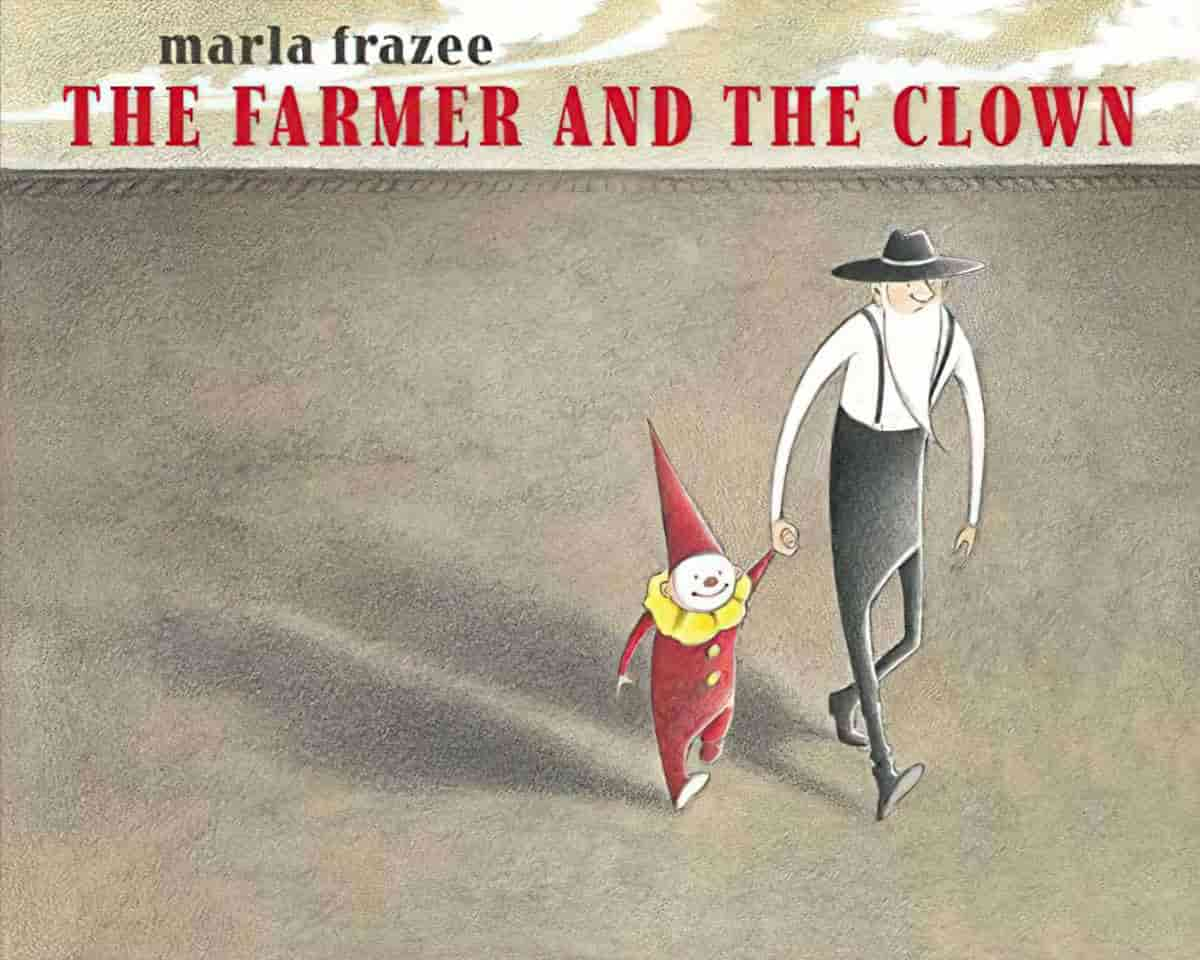This month I’m blogging a series aimed at teaching kids how to structure a story. This seven-step structure works for all forms of narrative. It works for picture books, songs, commercials, films and novels. Today I take a close look at The Farmer and the Clown by Marla Frazee to show how universal structure exists behind all good stories, even when those stories don’t have words.
(Frazee is pronounced FRAY-zee.)
The Farmer and the Clown is part of a trilogy. Frazee has said that they can be read ‘individually, and taken together, with a beginning, middle and end. The FARMER AND THE MONKEY is the “winter” book; a time of seeking warmth.
STORY STRUCTURE OF THE FARMER AND THE CLOWN
The Farmer and The Clown is an example of a carnivalesque story. Carnivalesque stories are popular with children. ‘Carnivalesque’ is a term coined by a guy called Mikhail Bahktin to describe the kind of story in which a character breaks away from ordinary life for a while and has fun. At the end of the story the character returns to their ordinary life. In this case, two characters go off on a picnic.
Carnivalesque tales don’t necessarily have a single thing to do with ‘carnivals’, though in The Farmer and The Clown, Frazee has taken characters from a circus to use in her story.
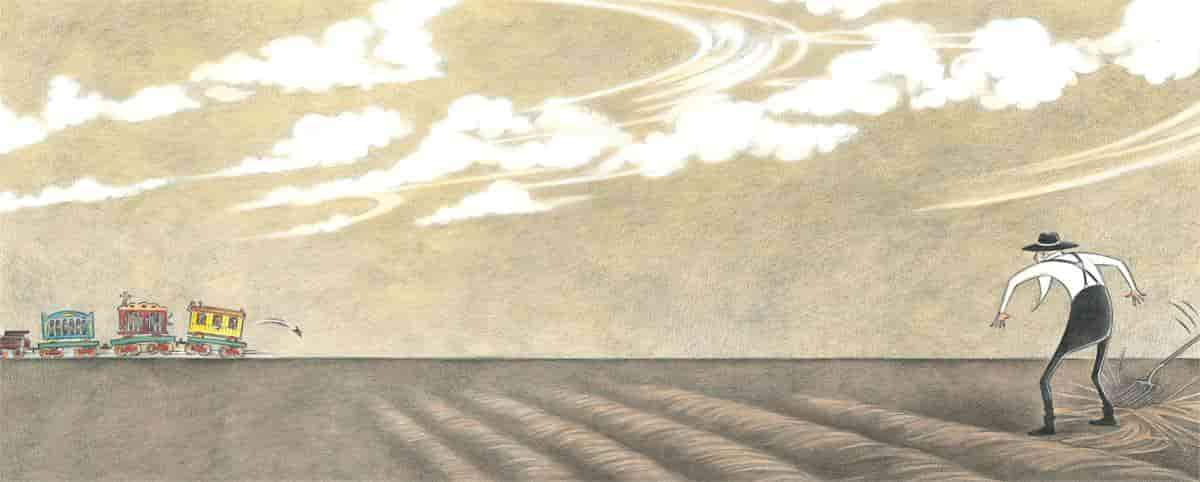
For more on picnics in children’s literature, see this post.
WHO IS THE MAIN CHARACTER AND WHAT IS WRONG WITH THEM?
Who is the main character? This question isn’t always as easy to answer as it seems. In this case the title suggests two characters who are equally central to the story. Sometimes a story is about a pair/group of people equally. If you’re not sure, here’s the question to ask: Who changes the most over the course of the story?
I argue that the farmer changes the most. Therefore, the farmer is the main character in this story, by a little bit. The young clown also changes, I guess. He or she learns that being separated from family can be fun, but not for too long or you start to get homesick.
What’s wrong with the farmer? He is isolated. The single chair on the verandah shows that he lives alone, and we know that even before we’re inside his house.
What’s wrong with the child clown? They are missing their own family, and because of youth, there’s no easy way to get back.
WHAT DO THEY WANT?
Carnivalesque stories tend to be unvarying in some of these steps. In a carnivalesque tale, the characters always desire fun. They desire a break from the routine and restrictions of their regular lives. But they also need to return to those regular lives at the end of the story. Unending fun is as terrible as never-ending routine.
OPPONENT/MONSTER/BADDIE/ENEMY/FRENEMY
This is tough. I’m trying to persuade you that every story needs an opponent. But where’s the opponent in this story? At first glance there is no opponent — just hard circumstances (falling off a wagon and becoming separated from family).
Here’s the thing, though: ‘Opposition’ is often very subtle. All this means is that the characters want different things. It doesn’t mean they have to have a big fight because of their differences. Sometimes the characters are very loving. (Another example of this kind of story is Sam and Dave Dig A Hole, in which two characters are always happy in each other’s company, never arguing.)
Frazee depicts a different kind of opposition in this wordless picturebook.
Look at the farmer’s face when we first see him. He looks grumpy, right? We assume he’s a grumpy old miser who prefers to be alone.
Look at the little clown’s face. They have a painted on smile, but we assume he is happy. It’s only when the face-paint is washed off that we see they are not happy at all.
Frazee thereby presents an opposition between the characters and the reader, bringing the reader into the story as one of the participants.
When the farmer says goodbye to the little clown, his hands are clasped firmly behind his back. This tells us that he knows he has to say goodbye to the little clown, but he doesn’t want to. He’s restraining himself from leaping forward and keeping the clown for himself.
WHAT’S THE PLAN?
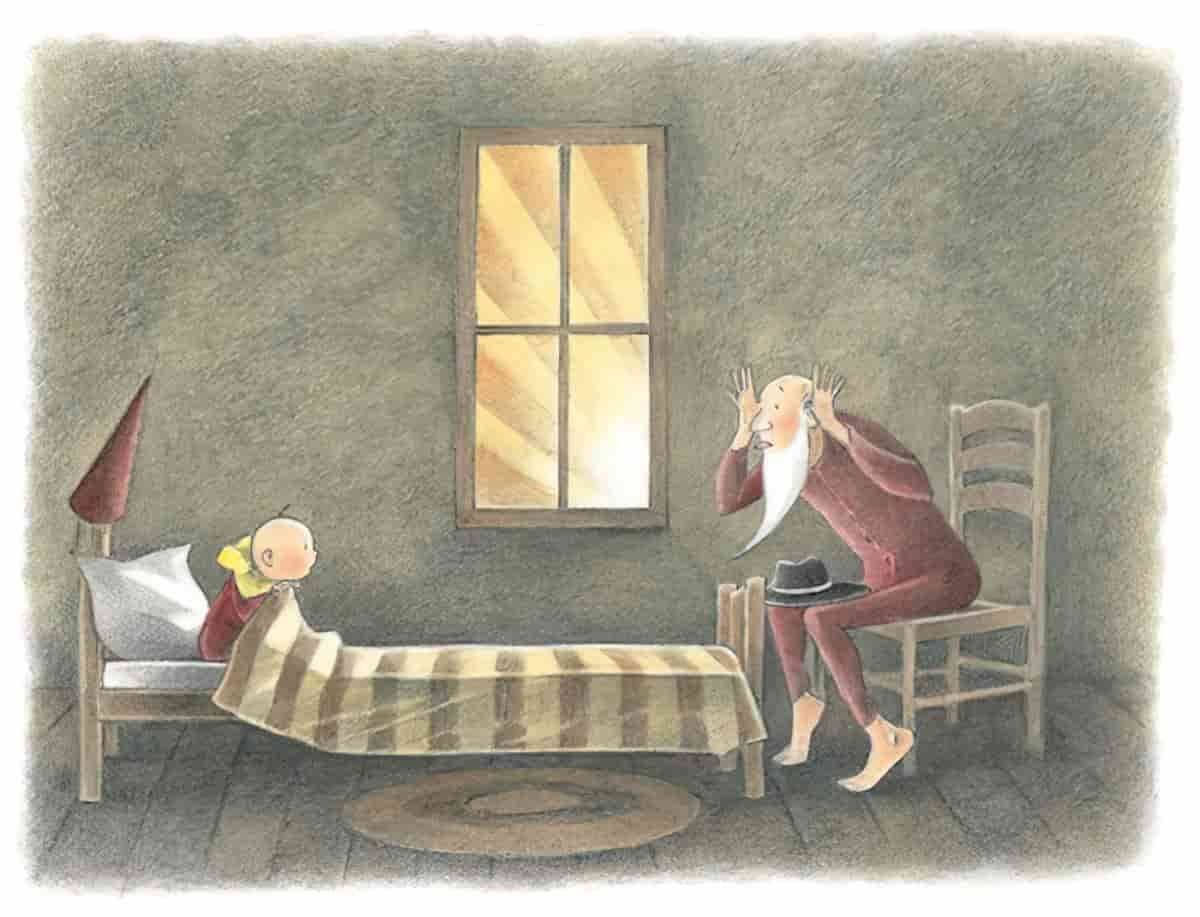
The farmer has no idea how to get the clown back with their family, so he simply looks after them. When the little clown becomes sad, he goes out of his way to make their time together fun, by teaching the clown how to milk a cow, by doing tricks with his hat, by taking them on a picnic.
BIG STRUGGLE
The big struggle scene of this story is as subtle as the opposition. (If the opposition is subtle, the big struggle will be, too.)
The big struggle is an inner struggle. This is what makes The Farmer and The Clown so masterful — Marla Frazee uses no words, yet we still know exactly how that farmer is feeling when he is forced to say goodbye to the little clown. It’s all in those hands, clasped behind his back.
WHAT DOES THE CHARACTER LEARN?
Another way of putting this: How does the character change? What is the character arc?
In old tales, like the fairytales transcribed by Charles Perrault, stories for children ended with a paragraph about what the child reader should take away from the story.
Moral: Children, especially attractive, well bred young ladies, should never talk to strangers, for if they should do so, they may well provide dinner for a wolf. I say “wolf,” but there are various kinds of wolves. There are also those who are charming, quiet, polite, unassuming, complacent, and sweet, who pursue young women at home and in the streets. And unfortunately, it is these gentle wolves who are the most dangerous ones of all.
The ending Perrault gave to Little Red Riding Hood
These are called ‘didactic’ (moralistic) stories and are no longer published for modern kids. Exception: Overt, didactic messages are still found in ironic children’s literature, which pokes fun at those old didactic tales. Lemony Snicket started that big trend in middle grade fiction, but there must have been something in the air, because in the same year A Series Of Unfortunate Events was published, we had the massive hit series from Nickelodeon, SpongeBob Squarepants (1999), which often ends with a mock didactic message, sometimes in the form of an outro (musical sequence to end on).
Contemporary stories, even for the very young, are rarely obvious about what the character has learned. Sometimes, even in picture books, the character winds up dead, and has therefore learned nothing!
Still, characters must change in some way. We deduce this change for ourselves. The farmer now knows what it is to have young company. When he leaps into the air, trying to cheer up the little clown to get him out of bed the next morning, I’m reminded of Grandpa George from Charlie and the Chocolate Factory. Frazee makes use of the trope that old people regain some of their youthful vigour when exposed to youth and novelty.
Frazee received a letter from a grandmother whose three year old granddaughter had made the observation that when we meet someone, even after that person moves on, we have kept something about that person and made it a part of ourselves. (That kid is an emotional genius.) We deduce that the farmer has changed simply from spending a bit of time with this child.
How does the reader change?
Marla Frazee loves a Mem Fox quote which goes something like, “A good picture book changes the reader’s emotional temperature over the course of the story.”
In a story, it’s not always the character who changes. Oftentimes it’s the reader. Did you find yourself welling up as you finished reading The Farmer and the Clown? I did! I was perfectly happy before I opened this book, but by the end my emotional temperature had certainly changed.
HOW WILL LIFE BE DIFFERENT FROM NOW ON?
The young clown will be with his real family. The farmer has a new companion, so we can extrapolate that he won’t be as lonely as he was before.
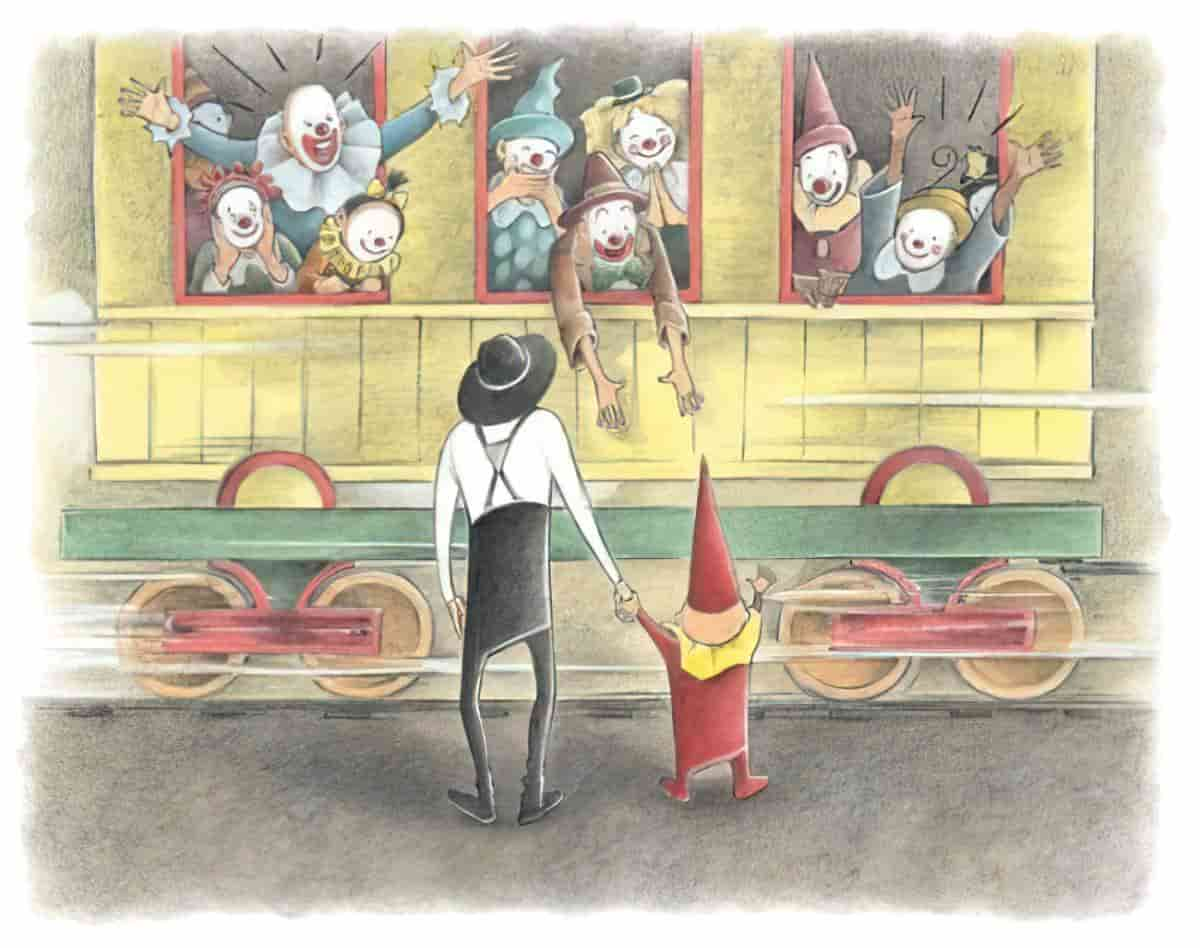
Found Family
A lot of children’s stories are about ‘found family’. A young character has no family, or a terrible family, so goes out into the big, wide world and meets a person/people to call kith and kin. This kind of story can still work, so long as the author makes it clear that the child had no family to begin with. Contemporary stories about found family have a real-life political backdrop of children who have been taken from their families, often for no good reason. Speaking of Samson and Delilah, here in Australia The Stolen Generation and their descendants are still dealing with the intergenerational trauma of Australia’s White Australia policy, in which Aboriginal children were taken from their families and placed in White families. Other countries have similar histories.
This is why every piece of art is political. When authors write picture books, even carnivalesque picture books like The Farmer and the Clown, history has an impact on the story. When the young clown reunites with his family of clowns, this is a good thing. We know this, because the clowns are clearly excited to see him (or her). The farmer may or may not be sad to see him go, and lonely from now on. Frazee’s ending makes for a perfect blend of bittersweet which, ideologically, is very much a story of its time: ‘If you have a family who care for you, your own people are always the best people for you.’
Marla Frazee softens the ending a bit. When you turn the page, the final spot illustration shows that the monkey has jumped off the wagon to join the farmer. The monkey has one finger to his/her lips, looking conspiratorially at the reader. A lot of picture books end in this way — this is a circular plot. Now we know that this story is going to play out again, but this time with a monkey. Perhaps the clowns won’t come back for the monkey. This is acceptable in a contemporary milieu because the monkey never was part of the clown family — itself stolen from its own kin. We can imagine the monkey will stay with the farmer forever, keeping him company.
NOTES ON THE ILLUSTRATION OF THE FARMER AND THE CLOWN
Marla Frazee works with real media rather than digital illustration. She feels that even when hand-painting something that would be heaps faster on a computer, the subtle difference between hand-painted and digitally painted art is worth it. As a child she hugely appreciated the time and effort that went into the illustrations that appeared in her favourite picture books. (I would like to add, from experience, that it’s perfectly possible to do painstaking hand-drawn work straight onto a computer, via a tablet.)
Marla Frazee says in this video that she is influenced by Maurice Sendak, who is most famous for Where The Wild Things Are. It’s easy to forget this now, but when Wild Things came out it was unlike anything that had come before, in its honest expression of a child’s strong emotions.
Frazee was also influenced by Blueberries for Sal by Robert McCluskey (who also wrote Make Way For Ducklings).
Frazee also says she loves stories in which an older person tells a story about what happened to them as a younger person, which then inspired what they do as adults. The fancy name for this kind of story is hypodiegetic narration.
The farmer’s cottage in the middle of nowhere reminds me very much of the setting of Courage the Cowardly Dog, a Cartoon Network show from the late 1990s.
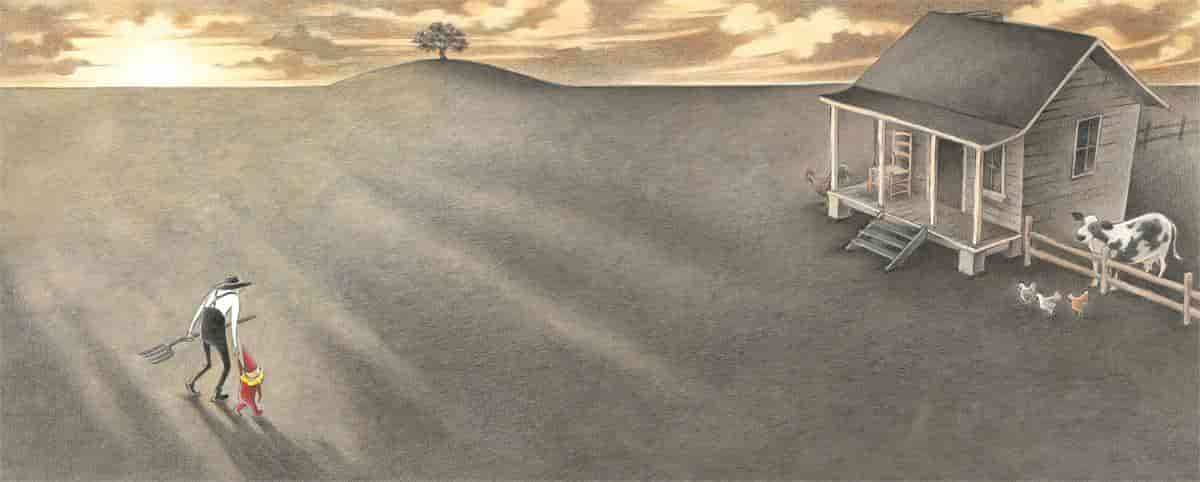
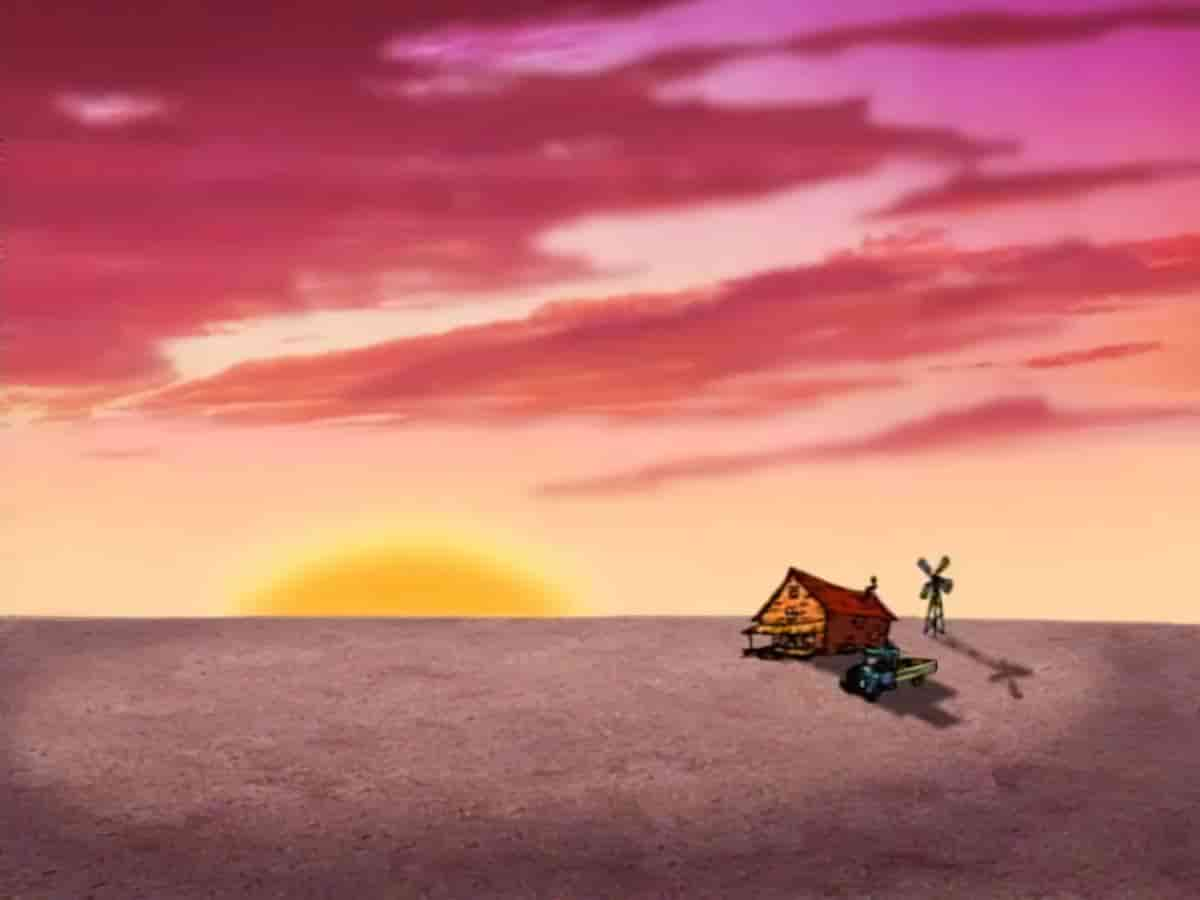
A small, rickety house in the middle of an empty plain also reminds me a lot of Samson and Delilah, an Australian film about two Aboriginal teens learning to live independently in the Australian outback. (A must watch for teenage viewers and older, because not much of Australia looks like the set of Neighbours or Home and Away.)
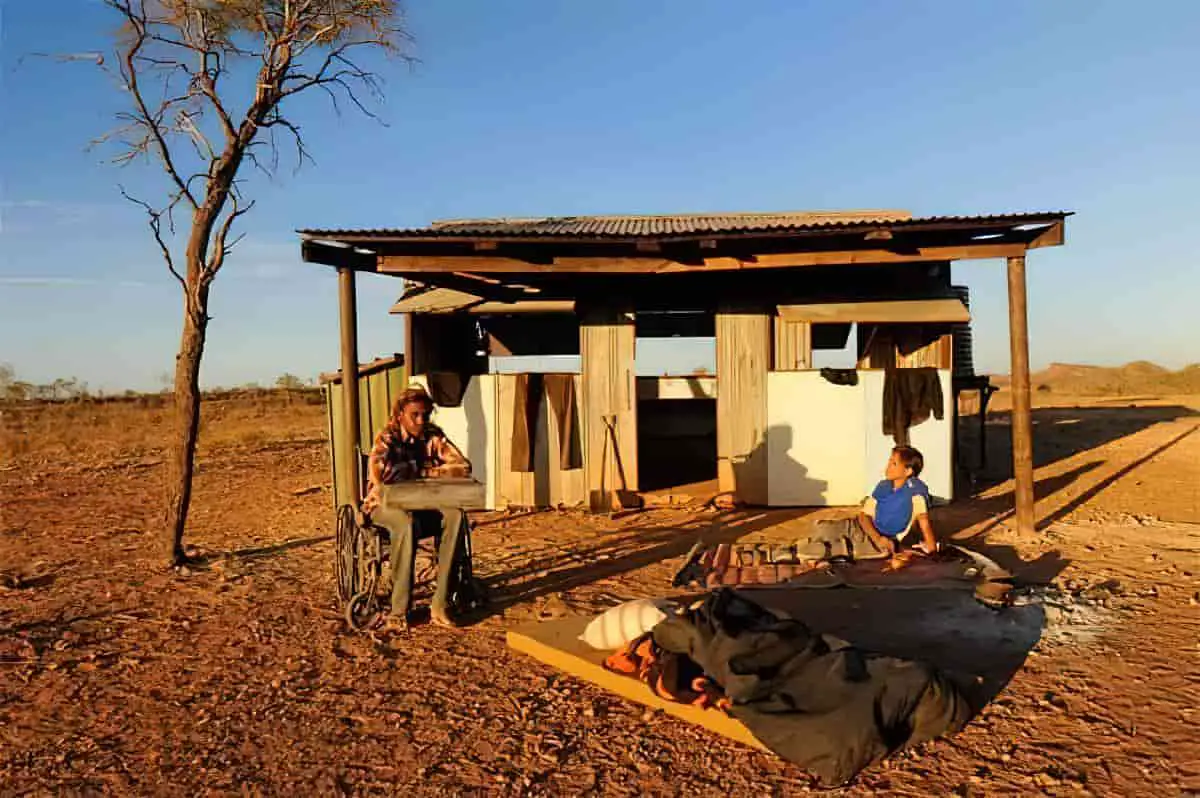
When characters exist in a small cottage in the middle of nowhere, this increases the vulnerability, which also increases our sympathy. Notice too how Marla Frazee chose to keep her ‘camera’ higher than the characters. We’re looking at the farmer and the clown as if we’re up high, like we’re birds. This also makes the pair seem vulnerable, and also young and small. Even though the farmer is an adult, we can consider both farmer and clown as children. They both have a childlike sense of fun.
When the child clown reunites with his clown family inside the wagon, we know that the farmer will be alone once more. Did you feel a pang of sadness for him?
Colour Palette of The Farmer and the Clown
The palette is ochres, though the end papers are red to lend some colour. (Clowns are also associated with red because of their noses.) The clowns themselves are colourful, showing that they are not a part of this environment. The clowns belong to an entirely different world.
Dreamy
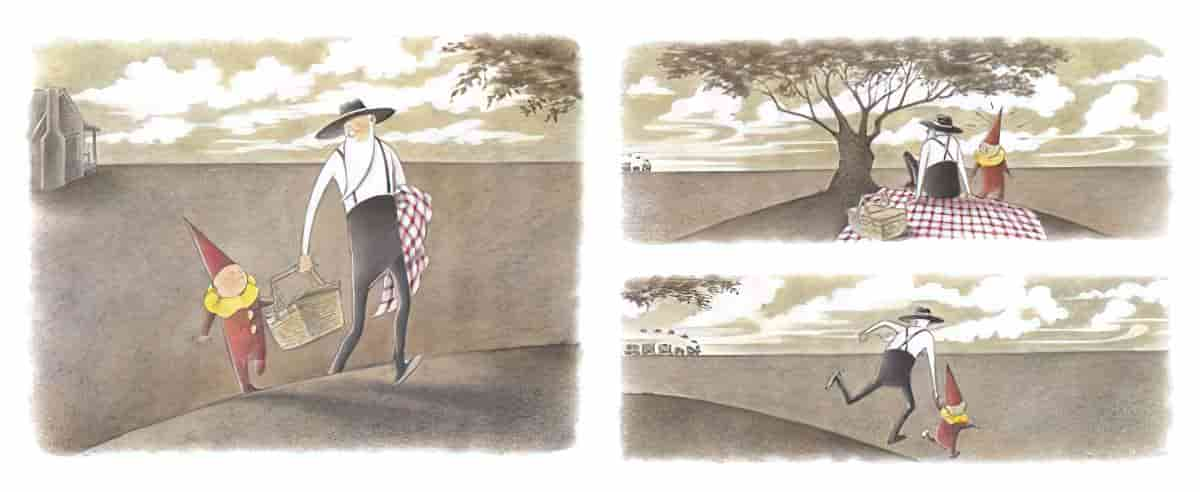
Many of the illustrations are not full bleed, meaning they don’t fill the entire page. (I’m not talking about the spot illustrations either, which are small pictures without the background.) A number of the illustrations in this book are almost a cross between full bleed and spot, with a fuzzy border. This lends a dreamy atmosphere to the story. Have you ever had an unusual experience which, looking back, feels almost like you dreamt it? For me, the years I spent in Japan as an exchange student feel like a dream now, because the experience was so different from my normal life and also because it happened a long time ago. I’m not sure young readers have been around long enough to know what memories turn into after several decades, but adult readers would.
Continuous Narrative in The Farmer and The Clown
There is a type of narrative art known as ‘continuous narrative‘. Marla Frazee is a big fan of this type of illustration, and includes an example in most of her picture books. Here’s an example:
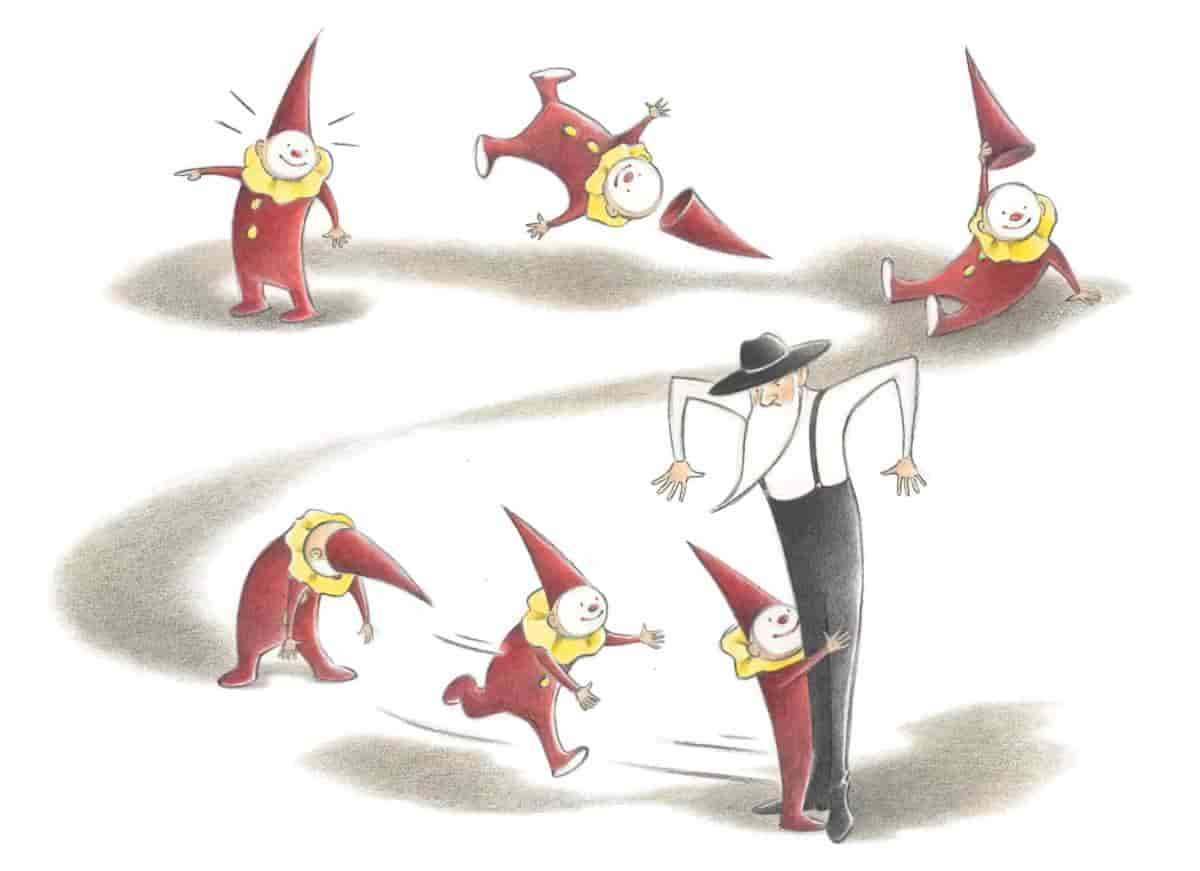
The youngest readers of picture books don’t understand that there is only one little clown. They think there are six identical clowns. But after exposure to enough books, we learn to decode pictures as they are intended: There are not six clowns but one, and this is the same clown in six different states. Continuous narrative in illustration is good for depicting movement.
STORY SPECS OF THE FARMER AND THE CLOWN
The Farmer and The Clown won the Horn Book’s ‘Mock Caldecott’ 2015 by a country mile, but lost out when it came to the real Caldecott Medal. (You know what won? Dan Santat’s The Adventures of Beekle: The Unimaginary Friend, also very good, obviously.)
Marla Frazee is also well-known for illustrating the Clementine middle grade novels and for writing Boss Baby, recently turned into a feature film by DreamWorks.
